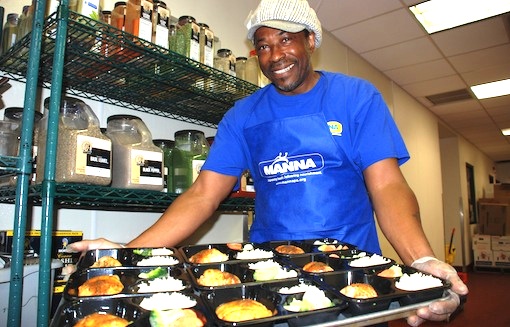Could MANNA Save the Health-Care System?

Stanley Wilson is first cook at MANNA, a meal program where dietitians work closely with chefs to provide meals for the critically ill. Photo courtesy of MANNA
Sue Daugherty will never forget the day she got the phone call. Crying, the woman on the other end explained to Daugherty that she fed her daughter popcorn for lunch. A breast-cancer patient, the woman often found herself too exhausted to cook.
Daugherty is the executive director of the Metropolitan Area Neighborhood Nutrition Alliance (MANNA). MANNA provides medically appropriate meals—three a day, free of charge, meeting very specific dietary needs—to people who are at acute nutritional risk and battling critical illnesses such as cancer, renal disease and HIV/AIDS. It serves 950 patients and 75,000 meals a month in nine counties in the greater Philadelphia region.
MANNA provides a crucial, lifesaving service—that’s why Daugherty got into the work to begin with. But as she and her team recently learned, MANNA’s work could do an even greater good, if given the chance: it could bolster health care’s bottom line.
Last summer, MANNA released the results of a small, three-year pilot study that measured how the program influences health spending. The goal was to strengthen their case for becoming a health-insurance-covered program. The steady cash-flow from insurance-reimbursement payments would ease some of the organization’s fundraising burden; currently, MANNA relies heavily on individual donations and grant money.
In conjunction with the OMG Center for Collaborative Learning, the study looked at more than three years of health-care claims from a local managed-care organization and found significant differences in costs for the 65 MANNA clients they studied.
The average monthly health-care cost for patients with HIV/AIDS was $16,765 for MANNA clients and $37,287 for the comparison group. Researchers also compared health-care costs for MANNA patients before and after they became a part of the program and found that their health-care costs fell more than 80 percent within the first three months of joining.
When MANNA clients needed hospitalization, they had half the number of average monthly visits than the comparison group and their length of stay for inpatient visits was 37 percent shorter. MANNA clients were also 20 percent more likely than the comparison group to be released from the hospital to their homes rather than to long-term care or health-care facilities.
“The study shows that we can keep people out of hospitals, so why wouldn’t insurance want to reimburse us?” Daugherty says.
Daugherty and other MANNA staffers believe that the meal program should be given as a discharge prescription and be regarded as preventative care. Why? Because while people with HIV/AIDS, for example, are living longer, the medications they take often put them at risk for high blood pressure and high cholesterol, and they can also develop heart and liver disease. Diet and nutrition education are extremely important in order to prevent these conditions and lower the side effects of the medication as much as possible.
“What sets us apart is the science behind our menu,” Daugherty says. “The key is proper nourishment for you to get optimal results from your treatment.”
While the results of the MANNA study are a huge step for the organization, it’s not the program’s only milestone. Aside from evolving from a supplementary to a complete meal program in 2007 and witnessing all the good MANNA is doing for its clients, Daugherty says one of the things that makes her most proud of her work is seeing all the volunteers in the kitchen—more than 100 on a given day.
“The people in the kitchen are there because they’re compassionate and they believe,” Daugherty says. “And the diversity of the group is so inspiring. Some are former clients who have gotten better and want to give back, others are there because they want to be. . . . They come from all walks of life.”
This article first appeared in the Liberty City Press.
Related Post
Un-Scrooge Yourself: Why It’s Good for You to Give Back


